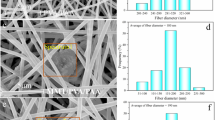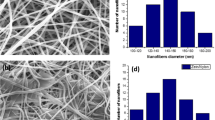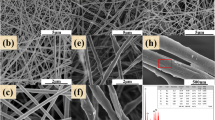Abstract
Bioinspired hybrid nanofibers on the basis of polystyrene and Spirulina biomass—pristine and modified—were produced. These nanofibers were characterized by scanning electron microscopy, Fourier-transform infrared spectroscopy, and thermogravimetric analysis. The hybrid nanofibers have been utilized as adsorbents for the removal of copper and manganese ions from synthetic solution in batch mode at pH = 7, during a 2-h experiment. The maximum adsorption capacity was achieved for nanofibers with maximum Spirulina biomass loading: q = 8.7 mg/g for copper and 7.3 mg/g for manganese (with pristine biomass); q = 8.2 mg/g for copper and 7.0 mg/g for manganese (with modified biomass). The obtained results showed that the hybrid nanofiber could be successfully applied for metal removal from industrial effluents.







Similar content being viewed by others
References
Fu F, Wang Q (2011) Removal of heavy metal ions from wastewaters: A review. J Environ Manag 92:407e41. https://doi.org/10.1016/j.jenvman.2010.11.011
Jan AT, Azam M, Siddiqui K, Ali A, Choi I, Mohd Q, Haq R (2015) Heavy metals and human health: mechanistic insight into toxicity and counter defense system of antioxidants. Int J Mol Sci 16(12):29592–29630. https://doi.org/10.3390/ijms161226183
Morillo Martín D, Faccini M, García MA, Amantia D (2018) Highly efficient removal of heavy metal ions from polluted water using ion selective polyacrylonitrile nanofibers. J Environ Chem Eng 6:236–245. https://doi.org/10.1016/j.jece.2017.11.073
Montes-Atenas G, Schroeder SLM (2015) Sustainable natural adsorbents for heavy metal removal from wastewater: lead sorption on pine bark (Pinus radiata D.Don). Surf Interface Anal 47:996–1000. https://doi.org/10.1002/sia.5807
Zinicovscaia I (2018) Biosorption of trace elements. In: Chojnacka K, Saeid A (eds) Recent advances in trace elements: chemistry, biology, biomedicine and environment. Wiley, London, pp 235–250
Omri A, Benzina M (2012) Removal of manganese(II) ions from aqueous solutions by adsorption on activated carbon derived a new precursor: Ziziphus spina-christi seeds. Alexandria Eng J 51:343–350. https://doi.org/10.1016/j.aej.2012.06.003
Suguna M, Subba Reddy A, Siva Kumar N, Krishnaiah A (2012) Biosorption of manganese(II) ions from aqueous solution by glutaraldehyde cross-linked chitosan beads: equilibrium and kinetic studies. Adsorpt Sci Technol 28(3):213–228. https://doi.org/10.1260/0263-6174.28.3.213
Parvathi K, Nareshkumar R, Nagendran R (2007) Manganese biosorption sites of Saccharomyces cerevisiae. Environ Technol 28(7):779–784
Abu Al-Rub FA, El-Naas MH, Ashour I, Al-Marzouqi M (2006) Biosorption of copper on Chlorella vulgaris from single, binary and ternary metal aqueous solutions. Process Biochem 41(2):457–464
Carolin CF, Kumar PS, Saravanan A, Joshiba GJ, Naushad M (2017) Efficient techniques for the removal of toxic heavy metals from aquatic environment: a review. J Environ Chem Eng 5(3):2782–2799. https://doi.org/10.1016/j.jece.2017.05.029
Papageorgiou SK, Katsaros FK, Kouvelos EP, Nolan JW, Le Deit H, Kanellopoulos NK (2006) Heavy metal sorption by calcium alginate beads from Laminaria digitate. J Hazard Mater 137:1765–1772. https://doi.org/10.1016/j.jhazmat.2006.05.017
Karnib M, Kabbani A, Holail H, Olama Z (2014) Heavy metals removal using activated carbon, silica and silica activated carbon composite. Energy Procedia 50:113–120. https://doi.org/10.1016/j.egypro.2014.06.014
Rathoure AK (2018) Effective removal of heavy metals from aqueous solution by nano-composites: bio remediation using nano technology in biostimulation remediation technologies for groundwater contaminants. IGI Global, Pennsylvania, pp 249–259. https://doi.org/10.4018/978-1-5225-4162-2
Masoudi A, Honarasa F (2018) C-dots/Fe3O4 magnetic nanocomposite as nanoadsorbent for removal of heavy metal cations. J Iranian Chem Soc 15(5):1199–1205. https://doi.org/10.1007/s13738-018-1318-y
Sun M, Li P, Jin X, Ju X, Yan W, Yuan J, Xing C (2018) Heavy metal adsorption onto graphene oxide, amino group on magnetic nanoadsorbents and application for detection of Pb(II) by strip sensor. Food Agric Immunol 29(1):1053–1073. https://doi.org/10.1080/09540105.2018.1509946
Bode-Aluko CA, Pereao O, Ndayambaje G, Petrik L (2017) Adsorption of toxic metals on modified polyacrylonitrile nanofibres: a review. Water Air Soil Pollut 228(1):35. https://doi.org/10.1007/s11270-016-3222-3
Peter KT, Johns AJ, Myung NV, Cwiertny DM (2017) Functionalized polymer-iron oxide hybrid nanofibers: electrospun filtration devices for metal oxyanion removal. Water Res 117:207–217. https://doi.org/10.1016/j.watres.2017.04.007
Mahapatra A, Mishra BG, Hota G (2013) Electrospun Fe2O3–Al2O3 nanocomposite fibers as efficient adsorbent for removal of heavy metal ions from aqueous solution. J Hazard Mater 258–259:116–123. https://doi.org/10.1016/j.jhazmat.2013.04.045
Musyoka SM, Ngil JC, Mamba BB (2013) Remediation studies of trace metals in natural and treated water using surface modified biopolymer nanofibers. Phys Chem Earth 66:45–50. https://doi.org/10.1016/j.pce.2013.09.002
Kampalanonwat P, Supaphol P (2014) The study of competitive adsorption of heavy metal ions from aqueous solution by aminated polyacrylonitrile nanofiber mats. Energy Procedia 56:142–151. https://doi.org/10.1016/j.egypro.2014.07.142
Ojuederie OB, Babalola OO (2017) Microbial and plant-assisted bioremediation of heavy metal polluted environments: a review. Int J Environ Res Public Health 14(12):1504. https://doi.org/10.3390/ijerph14121504
Zinicovscaia I, Cepoi L, Chiriac T, Yushin N, Vergel K (2018) Study of selected metals biosorption by Arthrospira platensis using neutron activation analysis. Desal Water Treat 108:119–124. https://doi.org/10.5004/dwt.2018.21940
Cecal A, Humelnicu D, Rudic V, Cepoi L, Ganju D, Cojocari A (2012) Uptake of uranyl ions from uranium ores and sludges by means of Spirulina platensis, Porphyridium cruentum and Nostok linckia alga. Biores Technol 118:19–23. https://doi.org/10.1016/j.biortech.2012.05.053
Fang L, Zhou C, Cai P, Wenli C, Xingmin R, Ke D, Wei L, Ji-Dong G, Qiaoyun H (2011) Binding characteristics of copper and cadmium by cyanobacterium Spirulina platensis. J Hazard Mater 190:810–815. https://doi.org/10.1016/j.jhazmat.2011.03.122
Zinicovscaia I, Safonov A, Tregubova V, Ilin V, Cepoi L, Chiriac T, Rudi L, Frontasyeva MV (2016) Biosorption and bioaccumulation of lanthanum, chromium, vanadium and uranium from single and multi-component batch systems by Arthrospira (spirulina) platensis biomass. Ecol Chem Eng S 23(3):401–412. https://doi.org/10.1515/eces-2016-0028
Chojnacka K, Chojnacka A, Gorecka H (2005) Biosorbtion of Cr3+, Cd2+ and Cu2+ ions by blue-green algae Spirulina sp.: kinetics, equilibrium and the mechanism of the process. Chemosphere 59(1):78. https://doi.org/10.1016/j.chemosphere.2004.10.005
Imran M, Haider S, Ahmad K, Mahmood A, Al-masry WA (2017) Fabrication and characterization of zinc oxide nanofibers for renewable energy applications. Arab J Chem 10:S1067–S1072. https://doi.org/10.1016/j.arabjc.2013.01.013
Nirmala R, Taek Nam K, Navamathavan R, Park SJ, Kim HY (2011) Hydroxyapatite mineralization on the calcium chloride blended polyurethane nanofiber via biomimetic method. Nanoscale Res Lett 6:2. https://doi.org/10.1007/s11671-010-9737-4
Solisio C, Lodi A, Torre P, Converti A, Del Borghi M (2006) Copper removal by dry and re-hydrated biomass of Spirulina platensis. Biores Technol 97:1756–1760. https://doi.org/10.1016/j.biortech.2005.07.018
Al-Homaidan AA, Al-Houri HJ, Al-Hazzani AA, Elgaaly G, Moubayed NMS (2014) Biosorption of copper ions from aqueous solutions by Spirulina platensis biomass. Arab J Chem 7:57–62. https://doi.org/10.1016/j.arabjc.2013.05.022
Goher ME, Hassan AM, Abdel-Moniem IA, Fahmy AH, Abdo MH, El-sayed SM (2015) Removal of aluminum, iron and manganese ions from industrial wastes using granular activated carbon and Amberlite IR-120H. Egypt J Aquat Res 41:155–164. https://doi.org/10.1016/j.ejar.2015.04.002
Celekli A, Yavuzatmaca M, Bozkurt H (2010) An eco-friendly process: predictive modelling of copper adsorption from aqueous solution on Spirulina platensis. J Hazard Mater 173:123–129. https://doi.org/10.1016/j.jhazmat.2009.08.057
Author information
Authors and Affiliations
Corresponding author
Additional information
Publisher's Note
Springer Nature remains neutral with regard to jurisdictional claims in published maps and institutional affiliations.
Rights and permissions
About this article
Cite this article
Shammas, M., Zinicovscaia, I., Humelnicu, D. et al. Bioinspired elelctrospun hybrid nanofibers based on biomass templated within polymeric matrix for metal removal from wastewater. Polym. Bull. 77, 3207–3222 (2020). https://doi.org/10.1007/s00289-019-02916-7
Received:
Revised:
Accepted:
Published:
Issue Date:
DOI: https://doi.org/10.1007/s00289-019-02916-7




